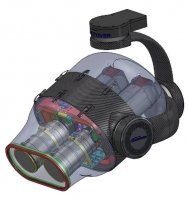I've understood from Denny's past posts that "5-axis stabilisation" refers to a gimbal-within-a-gimbal arrangement, whereby the outer (3-axis) gimbal corrects major errors and the inner (2-axis) gimbal cleans up any tiny remaining errors. I was happy with that until tonight when I read this:
The part I've highlighted in red - pitch and yaw? vibration removal? Dammit - back to square one! Can anyone explain this?
(from http://bradeng.com/product-gyro350)The system comprises of a 350mm diameter gimbal containing 5 independent, actively driven axes. 3 for major movements of pitch, yaw and roll and a further 2 axes of pitch and yaw for vibration removal. A total of 8 gyro sensors, 5 accelerometers and 3 magnetometers together with many other position monitoring sensors all work together into a number of digital microprocessors to deliver a state-of-the-art and cost-effective system.
The part I've highlighted in red - pitch and yaw? vibration removal? Dammit - back to square one! Can anyone explain this?

